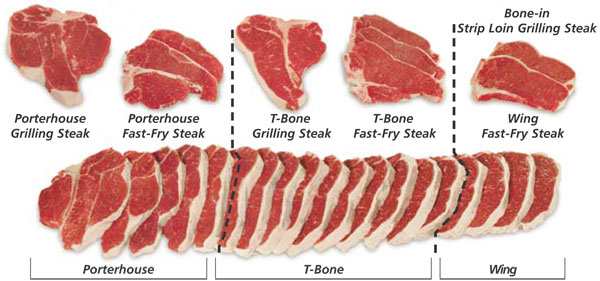Pasture-raised beef, even when tender and well-marbled, is leaner than grain-fed beef and its fat is less watery. Therefore, no matter how you choose to prepare your beef - grilling, broiling, frying - the most important thing is too cook it at a lower temperature than you would beef purchased at a grocery store. The lower the temperature, and longer the cooking time, the better.
In fact, it is best to reduce the cooking times of your favourite recipes by 25F to 50F for grass-fed beef, while maintaining the same cooking time. Grass-fed beef, on average, takes 30% less cooking time than grain-fed beef. So remember: Go low & go slow.
In order to maintain maximum tenderness, don’t cook beef to well-done. If it has to be well-done, marinate first. Use a meat thermometer to determine doneness. Rare: 120F; Medium Rare: 125F; Medium: 130F; Medium Well: 135F; Well Done: 140F.
Ground beef can also be very lean so you may have to add a little oil to the pan when browning or pan-frying hamburgers.

Because grass-fed beef is leaner, follow these tips to retain as much moisture as possible:
1. Never defrost beef in the microwave. Microwaving changes the texture and flavour of the meat and reduces moisture. Thaw in the refrigerator for 12 to 24 hour to melt all the ice crystals. or place in a plastic ziplock bag and thaw in cold water, changing the water every 10 minutes until completely thawed for even cooking.
2. Don’t cook cold steak straight from the fridge. Let it sit until it reaches room temperature for more even cooking.
3. Use tongs rather than a fork to to avoid puncturing the meat and letting juices escape.
4. Wait before serving. Grass-fed beef will continue cooking for several minutes after you remove it from heat. For this reason, you should remove it from heat just before desired doneness. Let meat sit for 5 minutes after cooking to redistribute juices, and keep it covered to minimize moisture loss through steam. For the same reason, don’t cut meat right away because the juices will escape.
The highest quality and most tender cuts of meat come from the rib and loin areas of the animal. This includes the rib steaks & T-Bone. Next comes the sirloin area which includes sirloin steaks and sirloin tip. These cuts are good for grilling, broiling and roasting. They can also be pan-broiled over low heat on the stove.

For best results, marinate before grilling, broiling or pan-frying. Pay extra attention to the type of cut, temperature and time because it is easy to overcook. Tender cuts such as Sirloin, T-Bone, Eye of the Round, as well as meat with greater fat content, are more forgiving, but searing on medium-high heat still risks toughening grass-fed beef. Still, many people willingly sacrifice texture for the smoky flavour imparted by searing to seal in the juices.
Round roasts are generally less tender. They are best marinated before grilling, pan-frying or broiling; or cooked in liquid in stews and as pot roasts.

This includes short ribs, blade steaks or blade and rump roasts. They taste best marinated, braised or roasted slowly in liquid. Braising involves browning meat and then cooking slowly in a small amount of liquid in a covered pan on the stove or in the oven the same as a pot roast.

| Type of cut | Cooking method |
| Rib Steak, T-Bone, Sirloin, Sirloin Tip | Grilling, broiling, pan broiling, roasting |
| Tenderloin Roast | Broiling, braising |
| Eye of Round, Rump Roast | Marinate before grilling, pan-frying, broiling or braising |
| Blade Roast, Short Ribs, Rump Roast | Slow cooking or braising |
| Fast Fry Steaks | Pan frying |
| Stewing Beef | Marinate and stir-fry, slow cooking |
Grilling: On medium-high heat, place meat directly on grill or in dry, pre-heated pan. Sear 3-6 minutes per side depending on thickness. Then, reduce heat to medium or low to finish cooking. Baste to moisten throughout the cooking process.
Pan-frying: Sear as with grilling before turning down temperature to medium low. Alternatively, use medium-low temperature throughout. Rub butter or oil on the steak before putting it in a dry, preheated pan. This ensures the pan is nice and hot for good searing, and will help prevent the steak from sticking to the pan. If desired, baste with a couple of pats of butter to get an authentic steakhouse flavour. Cook until the meat no longer sticks to the pan and is ready to turn.
Oven Broiling: This can also make the meat a bit tougher so compensate by placing beef on the 2nd highest rack so that it is farther from the broiler element. Or, place on the highest rack for a minute or two on each side and then finish cooking in the oven at 250F.
Braising: Rub with olive oil, salt, pepper and desired seasonings. Heat large pan on medium, sear each side until it no longer sticks to the pan, Add desired seasonings, 2 tsp of water, cover and turn burner to low. Cook at least 2 hours, depending on size. Use meat thermometer to determine doneness.
Pot Roast: You can grill each side of the roast for a minute or two before slow cooking. Then, in either a slow cooker or a pan, add water 1/4 to 1/2 the height of the roast. Add wine or vinegar, season to taste and cook at low temperature. Some recipes call for oven-cooking 3-4 hours, and others recommend slow-cooking for 8-10 hours. Cooking at 250F ensures even cooking without drying out the meat.
Suggestions for Marinating:
Using wine or vinegar helps tenderize meat. Oil locks in flavour. Garlic, onions and celery impart flavour to any type of cut. A quick and simple way to marinate beef is to use salad dressing or packaged marinades. Or, experiment with your favourite seasonings.
Other resources:
http://www.themeatsource.com/cookingroastbeef.html